PRINCETON, NJ -- President Barack Obama averaged 44% job approval for his third full year in office, which ended Jan. 19. His third-year average is down slightly from his second-year average of 47% and much lower than his first-year average of 57%.

Obama's third-year average is based on approximately 175,000 interviews with U.S. adults conducted between Jan. 20, 2011 -- the second anniversary of his inauguration -- and Jan. 19, 2012.
Obama's job approval rating during his third year in office had its ups and downs, peaking at 53% in May and falling as low as 38% in August and October.
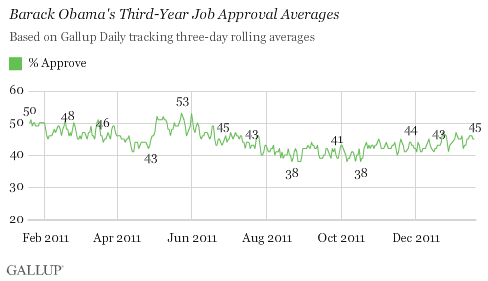
The higher ratings in May occurred after U.S. Navy Seals found and killed Osama bin Laden in Pakistan. Obama enjoyed a sustained rally in job approval -- his first real rally in public support -- averaging 50% approval for the month of May.
In late summer, after negotiations to raise the federal debt ceiling concluded, his job approval rating reached a term-low three-day average of 38%, which was matched in October.
In the final weeks of 2011 and early days of 2012, Obama's job approval rating showed some positive momentum, generally landing in the mid-40% range.
Obama's Third-Year Average Is Among the Lowest for Elected Presidents
Looking just at other elected presidents' third-year averages, Obama's 44% is among the lowest, better than only Jimmy Carter's 37% average in 1979-1980. Ronald Reagan's third-year average of 45% was similar to Obama's.
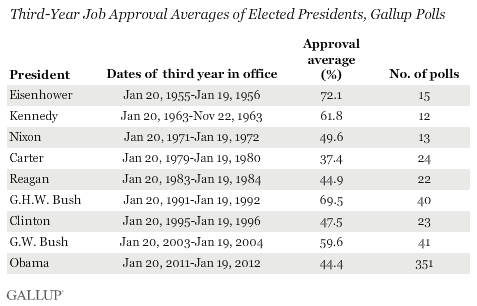
The fourth year in office for presidents is obviously critical, as they seek re-election. Historically, there is no clear pattern in the trajectory of presidents' job approval ratings from the third year to the fourth. Specifically, Dwight Eisenhower's and Carter's averages were essentially the same in their third and fourth years. Richard Nixon, Reagan, and Bill Clinton saw significant increases, and all were re-elected. George H.W. Bush and George W. Bush both saw significant declines in their approval ratings during their fourth year in office, with the elder Bush being defeated for re-election and the younger Bush winning a second term.
From a broader historical perspective, comparing Obama's third-year numbers with all presidential years in Gallup records, Obama's 44% average job approval rating is well below average, ranking 53rd of the 68 presidential years measured.
Obama's 12th Quarter Average, 43%, Is Lowest for Elected Presidents
The higher approval ratings for Obama in December 2011 and January 2012 led to an improvement in his 12th quarter average -- 43% in the period from Oct. 20, 2011, through Jan. 19, 2012, compared with his 41% 11th quarter average. Still, Obama's most recent quarters have been his worst in terms of job approval.
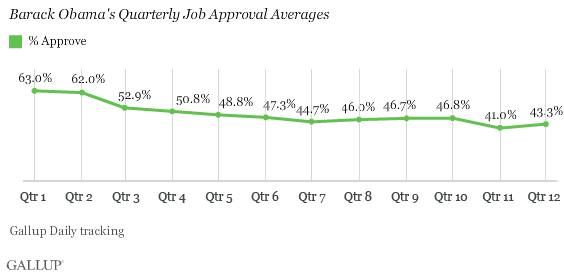
Despite the improvement in Obama's rating in the 12th quarter, it ranks as the lowest Gallup has measured in the comparable quarter for all elected presidents.
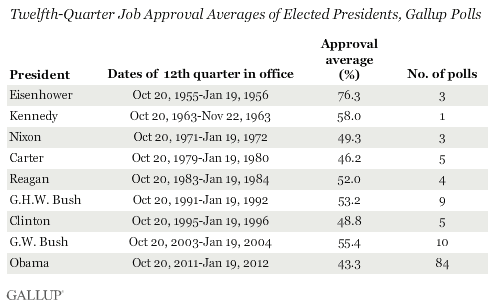
Perhaps the best indicator of Obama's re-election chances will be his approval average during his next quarter in office. All presidents since Eisenhower who were re-elected, including Lyndon Johnson, who assumed office after John Kennedy's death, averaged above 50% during the period of Jan. 20-April 19 of the election year. The three presidents who were not re-elected -- Gerald Ford (who took office after Nixon's resignation), Carter, and the elder Bush -- were below 50% at that time, and remained below that threshold up to the election.
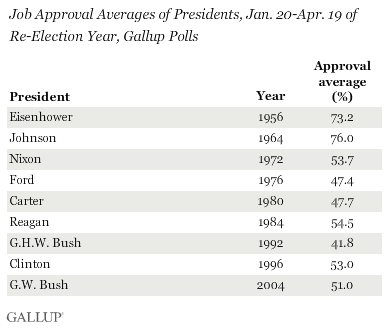
Implications
President Obama's recent job approval ratings look weak compared with those of his predecessors; his 44% third-year average ranks in the lower fourth of all years for which Gallup has data, back to the Truman administration. At the same time, Obama's approval ratings are improving, with upward momentum in his most recent quarterly average and with his daily average now sitting at 45%, closer to the 50% level that would make him a strong bet for re-election.
Explore President Obama's approval ratings in depth and compare them with those of past presidents in the Gallup Presidential Job Approval Center.
Survey Methods
Results for this Gallup poll are based on telephone interviews conducted Jan. 20, 2011, to Jan. 19, 2012, on the Gallup Daily tracking survey, with a random sample of approximately 175,000 adults, aged 18 and older, living in all 50 U.S. states and the District of Columbia.
For results based on the total sample of national adults, one can say with 95% confidence that the maximum margin of sampling error is ±1 percentage point.
Interviews are conducted with respondents on landline telephones and cellular phones, with interviews conducted in Spanish for respondents who are primarily Spanish-speaking. Each sample includes a minimum quota of 400 cell phone respondents and 600 landline respondents per 1,000 national adults, with additional minimum quotas among landline respondents by region. Landline telephone numbers are chosen at random among listed telephone numbers. Cell phone numbers are selected using random-digit-dial methods. Landline respondents are chosen at random within each household on the basis of which member had the most recent birthday.
Samples are weighted by gender, age, race, Hispanic ethnicity, education, region, adults in the household, and phone status (cell phone only/landline only/both, cell phone mostly, and having an unlisted landline number). Demographic weighting targets are based on the March 2011 Current Population Survey figures for the aged 18 and older non-institutionalized population living in U.S. telephone households. All reported margins of sampling error include the computed design effects for weighting and sample design.
The questions reported here were asked of a random half-sample of respondents on the Gallup Daily tracking survey.
In addition to sampling error, question wording and practical difficulties in conducting surveys can introduce error or bias into the findings of public opinion polls.
For more details on Gallup's polling methodology, visit www.gallup.com.
